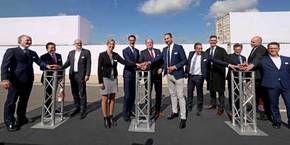Kategorien
Containers where carbon used to rule
Containers instead of coal. The new Duisburg Gateway Terminal was opened on 16 September. Inland hub operator Duisport said the day represented “one of the most important milestones in the more than 300-year history of the hub.” For Hendrik Wüst, the prime minister of the state of North Rhine-Westphalia, it represents “an outstanding example of successful structural change in the Ruhr region.”
The tenth container terminal in the inland port of Duisburg was opened recently in the presence of 250 special guests. The facility, located on a former coal island, took about two years to build and covers around 150,000 m2 today. Phase 1 of the project cost approximately EUR 120 million, of which approximately EUR 50 million consisted of state support.
Once it is completed, however, the Duisburg Gateway Terminal (DGT) will be the largest such inland facility in all of Europe, covering around 235,000 m2 and with the annual capacity to handle 850,000 teu.
That’s not all though. The DGT, which was built on old mining ground, is praised as a no less than “a model project for the future of logistics.” All goods movements on the site, which is the size of around 33 football pitches, are digitally controlled.
Completely climate-neutral
The ‘Enerport II’ energy concept also plays a decisive role in the project. “Cooperation between science and industry, and the courageous step towards implementation, are Ener-
port’s two outstanding qualities,” according to professor Anna Grevé, the engineer who heads the department of electrochemical energy storage in Germany’s Fraunhofer Institute for Environmental, Safety and Energy Technology. Enerport demonstrates, for the first time, that even a terminal of this size can be operated in a climate-neutral manner, with heat and electricity generated locally. To this end, a sustainable energy system will be installed at the DGT that will connect renewable energies, energy storage, consumers and hydrogen technologies.
In addition to a photovoltaic system, key components of Enerport include fuel-cell systems and hydrogen engines for power generation and battery storage. An intelligent local energy grid couples the various energy and storage systems – including shore power, charging stations as well as crane systems – to supply consumers in the terminal. On top of this word from Duisburg has it that it’s “theoretically also possible” to supply adjacent areas with power in the future.
Joint ventures for the future
Michail Stahlhut, the CEO of the Hupac Group, added that “the DGT sets new standards in terms of productivity and market proximity. Whether it’s the ARA ports, the Rhine-Alpine corridor or Eastern Europe – logistics in Europe will benefit from the new terminal.” The Swiss intermodal operator is one of the shareholders in the new facility, together with port operator Duisport, HTS Intermodaal and PSA.

